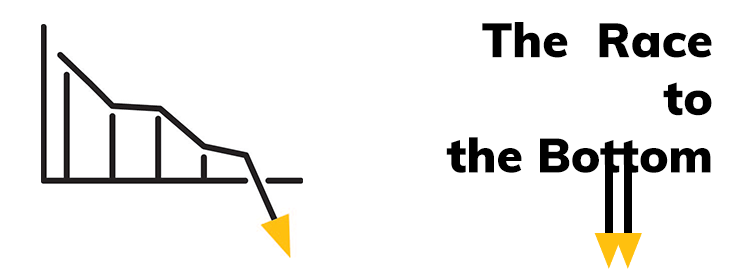
This is not the first time I have written about Race to the Bottom issues, nor will it likely be the last. However, I am prompted to raise this topic again given the rise in businesses, especially those in the building sector, going bust.
We work across industries and last week I was working with a B2B sales team in the building and construction sector about how to deal with their civil contractor clients who are caught in fixed price contracts (of their own making) with their developer clients and are now trying to avoid price increases with our client expecting them to absorb the costs.
This is an all too familiar problem in building and construction, highlighting a major issue plaguing customer-supplier relationships that has been festering for many years with significant consequences emerging now.
Propped up by generous government subsidies, short supply, and unstable pricing, Gold Coast developer Soheil Abedian puts the construction industry’s current woes down to one simple reason: greed. Meriton founder Harry Triguboff says, while he does not do pre-sales, too many builders locked themselves into this arrangement before material costs surged, and they were left out of pocket. These are just some of the reasons offered for the current situation.
However, for as long as I have been around – and I grew up in the building industry with my father’s wholesale timber and roof trussing business- ‘Race to the Bottom’ tactics have and still are a key feature of the building and construction sector.
Too many builders take a short-term focus looking to make as much money as quickly as possible, unconcerned with the consequences as they try to screw suppliers for every last cent and leave customers stranded. Often looking to win contracts from developers or clients with the cheapest bid they lock themselves into fixed price contracts and then expect their suppliers to bear the costs when things go bad. Granted there are suppliers who play the system too; however, who can blame them when many builders/contractors use suppliers as their default banks? It’s a very flawed system that impacts everyone across the value chain.
What is clearly visible in many sectors is a customer-supplier engagement strategy that relies solely on leveraging volume and market size to generate margin which then drags suppliers down in a pricing race to the bottom.
The ominous signs that many suppliers are caught in this race to the bottom were evidenced in recent press articles about the building and construction sector and include:
- Demands for price drops with no discussion of joint cost management strategies,
- Constant reminders that “we can get this cheaper elsewhere”,
- Repeated informal quotations or information quotation processes,
- Ongoing transfer of risk from buyers to suppliers, and
- Repeated changing of suppliers.
The Australian business environment is now littered with broken companies and their suppliers who together have engaged in toxic races to the bottom by pushing down prices lower than the supply chain can accommodate.
Being caught in this race has ensured that suppliers are forced to choose between:
- Lowering the cost of supplying either by accepting their own risks or lowering quality,
- Subsidising the cost of supply by relying on other higher margin customers, and/or
- Withdrawing from the relationship.
Unprofitable supply chains can only deliver risk and failure to those who depend on them. And this race will intensify for companies that have relied on price reduction as their strategy for survival.
We cannot cut our way to growth.
To survive and thrive it is essential that buyers and suppliers work together to find a fairer exchange of value to avoid this race of mutual destruction.
The race-to-the-bottom is a short-term game that ends up badly for everyone.
Suppliers can’t survive the relentless pressure to cut costs. Sooner or later, they won’t be able to keep their doors open. This not only hurts the businesses that have to close down and their communities, but it also hurts their clients who will find it more and more difficult to get the resources that they need to operate.
Not every client is a good client. It may look prestigious having a big brand name on your client page but at what cost to you and the longevity of your business?
Remember, everybody lives by selling something.
Related topics
How healthy & resilient is your sales system?
A year ago
Staying in touch for all the right reasons
Three years ago
Why Progress, NOT Perfection, helps us find Common Ground for the Common Good
Ten years ago


New Article Email Notification